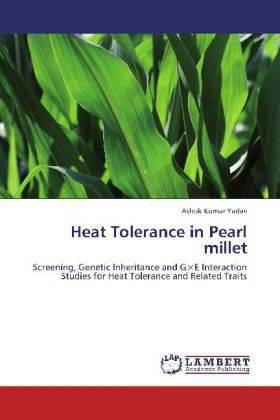
Je cadeautjes zeker op tijd in huis hebben voor de feestdagen? Kom langs in onze winkels en vind het perfecte geschenk!
- Afhalen na 1 uur in een winkel met voorraad
- Gratis thuislevering in België vanaf € 30
- Ruim aanbod met 7 miljoen producten
Je cadeautjes zeker op tijd in huis hebben voor de feestdagen? Kom langs in onze winkels en vind het perfecte geschenk!
- Afhalen na 1 uur in een winkel met voorraad
- Gratis thuislevering in België vanaf € 30
- Ruim aanbod met 7 miljoen producten
Zoeken
Heat Tolerance in Pearl millet
Screening, Genetic Inheritance and G×E Interaction Studies for Heat Tolerance and Related Traits
Ashok Kumar Yadav
Paperback | Engels
€ 104,45
+ 208 punten
Omschrijving
Adequate stand establishment of pearl millet continues to be a severe constraint to good production under subsistence farming conditions in the semi-arid tropics. Failure to obtain adequate plant populations is often associated with high temperature conditions occurring at critical times during the germination and seedling establishment process at farmers field which can only be managed through developing high temperature tolerant pearl millet varieties. Identification of the superior germplasm for heat tolerance is essential for effective manipulation through breeding. A major challenge in conventional breeding for heat tolerance is the identification of reliable and effective screening methods to facilitate detection of heat-tolerant plants. The book describes the screening methods (field screening and laboratory screening) and their validation for heat tolerance to identify superior heat tolerant genotypes. It also describes the genetic mechanisms and nature and magnitude of different types of gene actions involved in the inheritance of supra-optimal temperature tolerance in pearl millet.
Specificaties
Betrokkenen
- Auteur(s):
- Uitgeverij:
Inhoud
- Aantal bladzijden:
- 220
- Taal:
- Engels
Eigenschappen
- Productcode (EAN):
- 9783846581155
- Verschijningsdatum:
- 24/02/2012
- Uitvoering:
- Paperback
- Afmetingen:
- 152 mm x 220 mm
- Gewicht:
- 327 g

Alleen bij Standaard Boekhandel
+ 208 punten op je klantenkaart van Standaard Boekhandel
Beoordelingen
We publiceren alleen reviews die voldoen aan de voorwaarden voor reviews. Bekijk onze voorwaarden voor reviews.









